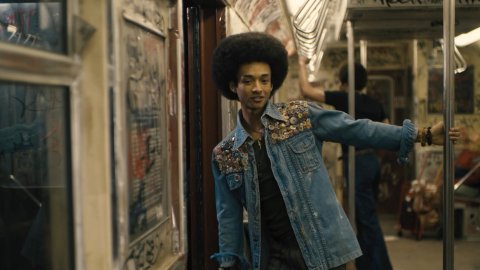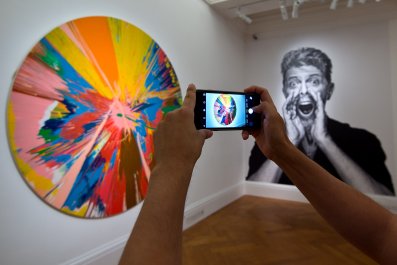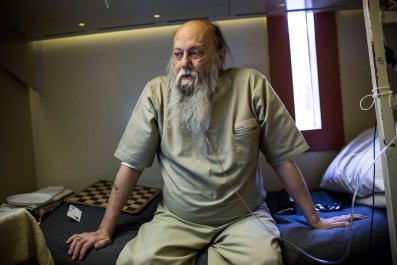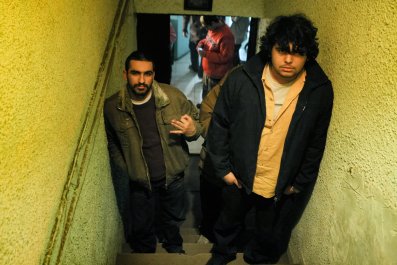When Paul Newman arrived to film on Simpson Street in 1980, the South Bronx greeted him with a Bronx cheer. The neighborhood had recently become famous, but it was celebrity of the unwanted kind, forged in the fires of 1977, started by arsonists and stoked by despair. Photographs of children playing in the rubble of buildings said almost everything anyone cared to know about the Bronx; news reports added grim statistics about the prevalence of crime and the absence of jobs. Everything wrong with the nation was crammed into a smoldering nub of land separated from Manhattan by the Harlem River.
Newman was there to turn the ruination of the Bronx into entertainment—that is, to make a movie, Fort Apache, the Bronx, about the beleaguered police officers of the 41st Precinct. The locals grasped that their neighborhood would play the role of the film's principal villain, the gritty agar from which emerged pimps in furs and junkies in rags, a lawless place that only the boys in blue, brogues strong and billy clubs swinging, could keep from devolving into primeval chaos. So they protested, targeting in particular the film's star: "Paul Newman: From Liberal to Racist for $3,000,000," said one sign. "Fort Apache is an anti-black, anti–Puerto Rican movie," said another.
The protests may have proved a distraction, but the film got made. There is, at its opening, a warning that what follows is a cop flick that can't possibly pay tribute to "the law-abiding members of the community," a flaccid concession that does nothing to temper Fort Apache's unrelenting cynicism. The film first scene has a prostitute, played by Pam Grier, assassinating two police officers. "It's not a police station," a seasoned denizen of the Four-One explains a little later. "It's a fort in hostile territory."
Baz Luhrmann, an Australian director, came to the South Bronx 35 years after Paul Newman for much the same reason: to film the borough, including its most troubled neighborhood, at its most troubled time, the summer of 1977, which is when most Americans first learned that there was more to the Bronx than Yankee Stadium and the famous zoo. Luhrmann, who is responsible for grotesquely lavish productions like Moulin Rouge and The Great Gatsby, was there to film The Get Down, a miniseries that combines the comic-book dystopia of Escape From New York with the razzmatazz of Guys and Dolls. Netflix has broken the 12-part series into two halves, the first of which begins streaming on August 12.
The South Bronx is still poor, but it now looks a lot more like Levittown in 1960 than Dresden in 1945. Once the victim of white flight, the South Bronx has become attractive to immigrants and people who can't afford Manhattan because they are not the progenies of a Siberian nickel-mining fortune, hedge fund impresarios or, at the very least, Instagram "influencers" who don't mind a Greenwich Village share without a proper bathroom. Proud of the neighborhood after so many inglorious years, residents were understandably on guard about the project. "Don't whitewash it Hollywood-style," a photographer who'd captured that mythical Bronx of beats and flames told DNAInfo. "You're beating a dead horse," cautioned a veteran graffiti artist. Luhrmann promised an "aspirational story" about the Bronx as a cradle of hip-hop and break dancing, the plein air studio that turned subway trains into garish Guernicas that some hated but everyone noticed. "At a certain point," he said at an event in the Bronx, "rubble is just boring."
He must have changed his mind, because the first episode of The Get Down, directed by Luhrmann, opens with a forced march of 1977's best-known clichés, including news footage of the capture of "Son of Sam" serial killer David Berkowitz, the recently risen towers of the World Trade Center and the famous Daily News cover line "Ford to City: Drop Dead" that voiced New Yorkers' frustration and, more subtly, their defiance. None of this is anything more than cursory mood-setting, lazy gesturing toward urban malaise by someone who skimmed Jonathan Mahler's outstanding The Bronx Is Burning and took a Post-It's worth of notes. The historical montage predictably ends at the very place Luhrmann promised to avoid, the images of smoldering rubble and hollowed-out buildings. The Get Down picks up where Fort Apache left off, without missing a single disco beat.
As the opening credits roll, we move between the Bronx in 1977 and a Madison Square Garden rap concert in 1996. The rapper onstage, the now-famous "Mr. Books," is the protagonist of The Get Down, Ezekiel Figuero (Justice Smith); we follow him through the summer of 1977 as he and his friends come under the tutelage of Shaolin Fantastic (Shameik Moore), who introduces them to the vocabulary of hip-hop: the scratched record, the looping beat, the rap verse. Figuero is also busy courting Mylene Cruz (Herizen Guardiola), whose dreams of being a disco queen are stifled by her father, a sanctimonious minister. Guardiola is the best thing about The Get Down. In fact, she may be the only good thing about The Get Down.

The story is simple, in keeping with Luhrmann's apparent belief that complexity confounds creativity. The Get Down could have just as easily been set in Peoria, or Pasadena, so little interest does it evince in any of the social forces that brought the Bronx to ruin and now presumably make 1977 more fascinating than, say, 1952. Sprinkled into the narrative is historical ruin-porn footage of the Bronx, the sort of obvious stuff a quick YouTube search will yield: apartment blocks aflame, cop cars screaming down Jerome Avenue...what have they done to my bubbe's Grand Concourse? This is a cheap means of indicating seriousness, certainly more difficult than doing the kind of challenging but deeply satisfying sociology David Simon put on display in Show Me a Hero, his recent HBO miniseries about racial politics in Yonkers in the late 1980s. A minor plot involving Mylene's uncle Francisco Cruz (Jimmy Smits, hamming it up and doing an amusing job of it) trying to bribe a housing development into existence plays out like a 13-year-old's version of city politics. Otherwise, The Get Down is just Moulin Rouge with bell-bottoms and fringed vests.
Of course, going to Baz Luhrmann for story would be sort of like going to Donald Trump for marriage counseling. He is famous for musical productions of feature length, ornately staged song-and-dance numbers that generally disregard the conventional features of storytelling, like character, plot and theme, not to mention anything resembling context. In his version of The Great Gatsby, West Egg pulsated with electronic dance music—not typically a feature of Jazz Age affairs. But his fans don't care. As with the aforementioned Mr. Trump, Luhrmann celebrates excess as a virtuous end in itself.
Luhrmann's attraction to the Bronx is easy enough to grasp. The borough has some of the richest music history of any place in America, rivaling Nashville and Detroit: Hip-hop began, in part, at DJ Kool Herc's parties in the basement of 1520 Sedgwick Avenue, an apartment building in the Morris Heights section; there was break dancing at Mom and Pop's Disco, graffiti at the Mosholu train yards. To get the Bronx right, Luhrmann enlisted DJ Grandmaster Flash, one of the originators of the Bronx hip-hop style; Kurtis Blow of "The Breaks" fame; the Queens rapper Nas, who wrote new music for the series; and cultural historian Nelson George. These are not people who needed to crib from Wikipedia. Given their input, The Get Down could have been an instructive and enjoyable work of anthropology. Then again, maybe a director who had Nick Carraway ceaselessly borne back into the past to the sounds of Lana Del Rey is beyond saving, a Colonel Kurtz deep in the humid jungles of his own imagination.
The Get Down is noisy but not especially musical, suffering from a cacophony of hip-hop beats that never build to anything thrilling or coherent. Well, almost never. There is one great scene, in which Mylene and her two friends dance to "Turn the Beat Around," a paroxysm of well-choreographed joy, and another in which the talented Yahya Abdul-Mateen II (playing a henchman named Cadillac) dances to Curtis Mayfield's "Superfly" while brandishing a gun. Good actors dancing to great music: If The Get Down were only this, it would be a fine entertainment. Instead, it tries to be something more, only to end up being something far less.
Is there a plot? I am not sure. Mostly, The Get Down—which went through several showrunners and has a baseball squad's worth of consultants and producers—suffers from attention deficit disorder. The first episode chronicles Mylene's efforts to get into a club; the second has something to do with a purple crayon. Will the show ever settle down, find a story to tell and the right music to tell it with? I was only privy to three episodes, but I am more hopeful about peace in the Middle East.
Nelson, one of the show's producers, has praised The Get Down for its diverse cast. Luhrmann has done a public service in introducing the viewing public to many promising young actors of color, most notably Guardiola and the charming, affably nerdy Skylan Brooks as Ra-Ra Kipling. But it is also undeniable that the cast of The Get Down is served incredibly poorly by the material, which comes perilously close to minstrelsy. Luhrmann could be as cartoonish as he wanted in his depiction of Parisian cabaret performers and New York flappers, but the Bronx is more fraught territory, and his treatment of black and brown bodies—teenage bodies, in particular—left me in deep unease.
For example, one of Mylene's friends, Regina Diaz (Shyrley Rodriguez, too talented for this role), spends so much of the first episode writhing in stripperish dance moves, I worried she might dislodge a hip bone. The male characters, meanwhile, universally exude a trite ghetto machismo expressed mostly by hurling enough f-bombs for a Quentin Tarantino film. Netflix has touted the amount of research about the history of the Bronx that Luhrmann and his team conducted. They would have been better served by a study of the human heart, which may have yielded the epiphany that the people of the Bronx were as irreducible to stereotype as those of Manhattan, or Houston, or Pleasantville.
And yet I doubt the creators of The Get Down ever wanted to do more than set the black and brown bodies of this series into an endless whirlwind of dancing, fighting, singing and jiving, hoping that this would pass for some gorgeous verisimilitude of what it was like down on Alexander Avenue in the sweltering months of '77. They used to call this blaxploitation. Of course, you can't call it that today. You can't honestly call it art either.
Luhrmann deserves the principal blame for this expensive disaster, but he is hardly the only artist to be entranced by the siren song of 1977. Last year saw the publication of Garth Risk Hallberg's City on Fire, a novel for which Knopf paid $2 million and whose readership probably couldn't fill Studio 54 on a Wednesday night in mid-August. The novel focused on the punk scene in Manhattan, through which Hallberg did not live, just as Luhrmann did not live through the fiery destruction of the Bronx. Can you make art about a past that is not your own? Yes, and if you're very good at it, you'll have something like E.L. Doctorow's Ragtime or Steve McQueen's 12 Years a Slave. But simply tweaking tropes, sexing up the past without bothering to deepen our historical understanding, is the surest way to kitsch.
The Get Down isn't just bad—it's insidious. Reveling in the depredations of 1977 is an elaborate avoidance strategy, a way to attenuate anxieties about today. Where tenements burned, condos now rise; subway trains are silver bullets of efficiency. The South Bronx is now SoBro, the mellifluous sobriquet rolling off the lips of loft-dwellers and lager-sippers. And yet not all is well across the land. The Bronx remains one of the very poorest places in the nation, suggesting that the improvements of the past three decades have been uneven and, in some cases, cosmetic. The Get Down can say nothing about 2016 because it has said nothing about 1977. Like the crew of Fort Apache, Luhrmann came to the South Bronx for a few hits of hardcore urban malaise. Having made his score, he followed the path of so many fine white scions of Westchester and Connecticut before him, fleeing across a bridge, out of the Bronx.





















